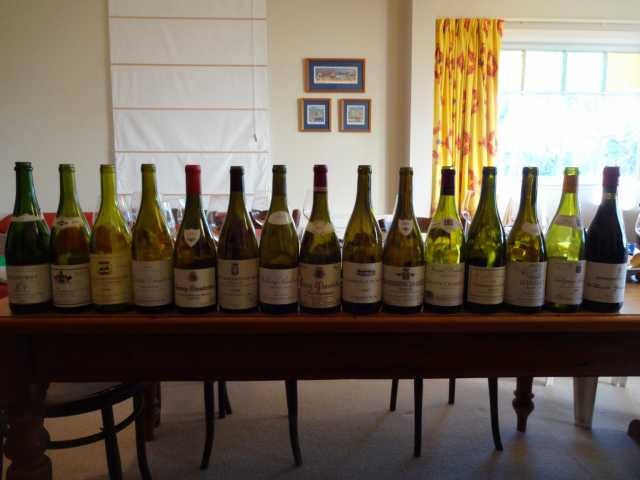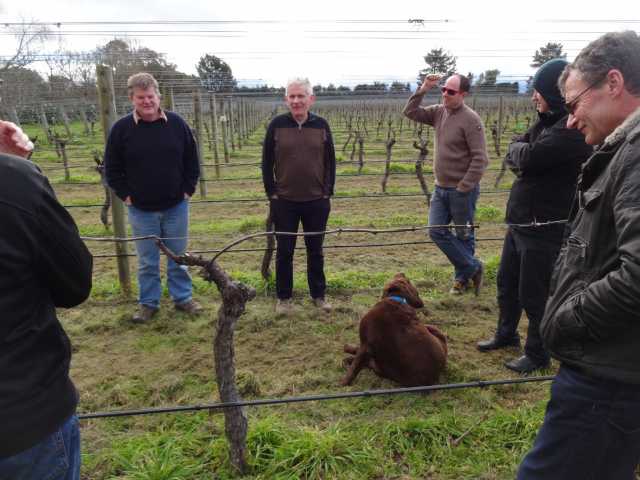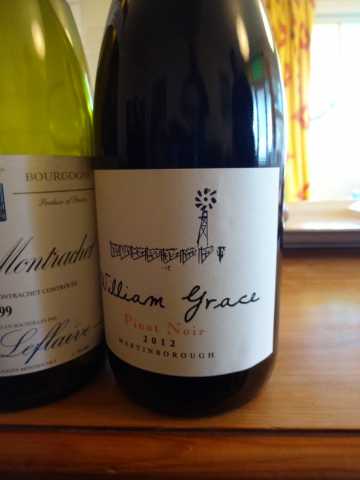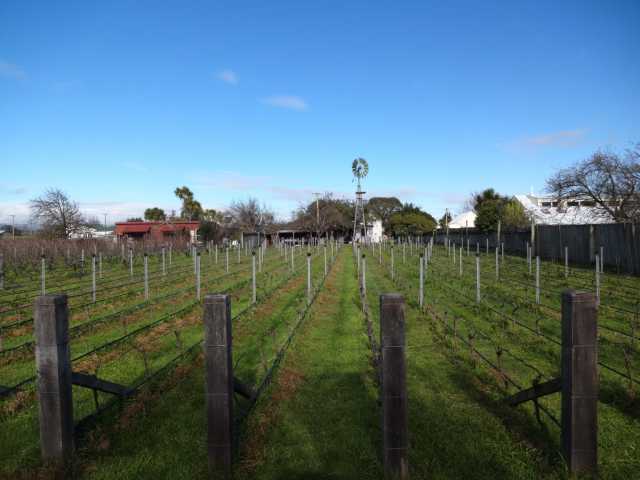Six of us decided to spend the day in Martinborough, starting with a visit to Escarpment Vineyards, where we were met by the winemakers Larry McKenna and Huw Kinch. We began with a discussion on the Escarpment vineyards, most of which are up on Te Muna Road where the winery is situated, the remainder being leased vines located around the northern corner of the village, on New York Street and Huangarua Road.
Larry then took us out to look at the Kupe Pinot Noir vines, unusually densely planted for a New Zealand vineyard at around 8000/ha, although some local enthusiasts are now emulating the Burgundian standard of 10,000/ha. The Kupe vines are trained low to the ground to maximize sun exposure, in a north-south orientation. They are planted on a loamy topsoil, under which it is Martinborough Terrace gravel all the way down, mandating skillful use of trickle irrigation; enough to prevent hydric stress, yet not enough to discourage root growth.
Huw took us down to the barrel room; a large high-walled concrete structure built into the side of a bank such that is effectively invisible except from the escarpment side of the property. There are plans to build a winery above it to allow gravity feeding to the barrels and cuves below. As a result of the subterranean location and the cool Wairarapa winters, malolactic fermentation is usually delayed until the following spring. This means that we were tasting the 2014 wines before malo, so my notes on the wines from this vintage are appropriately brief. All wines were tasted from barrel or tank.
Escarpment Vineyards Insight Series Pinot Noir wines
Escarpment Pahi Pinot Noir 2013. From the McCreanor vineyard, which is comprised of a mixture of own-rooted and grafted 10/5 clone vines, planted in 1986. Lifted red and dark fruit aromas, savoury earthy flavours and silky tannins transporting the dark fruit flavours to a graceful although not extended finish. This has the usual Pahi elegance enhanced by the 2013 fruit character.
Escarpment Kiwa Pinot Noir 2013. From the Cleland vineyard planted in UC Davis clones 5, 6 and 13. Spicey aromas, with Kiwa-signature savoury flavours. Power and richness that contrasts with the elegance of the Pahi; a bigger wine with more apparent matière. Lovely acidity that is a more obvious component of the framework at this stage than oak or tannin, although the elements are all there for long-term development.
Escarpment Te Rehua Pinot Noir 2013. From the Barton vineyard planted with a range of clones in 1990. This is usually the most fruit-driven and New World in style of the four Insight Pinots, and the 2013 is no exception. Dark berry aromas, a burst of fruit flavours on entry seasoned with peppery spices, the primary (although not inaccessible) quality of this wine contrasts with openness of the first two.
Escarpment Kupe Pinot Noir 2013. A 1.8 ha vineyard on Escarpment’s Te Muna Road property planted in Abel clone vines. This is the flagship of the Insight series single vineyard offerings. The vines here are around ten years younger that the other Insight vineyards and, in the winery, Kupe receives more whole bunch (60% in 2013) and more new oak (55% versus 40%), compared with the other Insight wines. As a result, Kupe has previously struggled to match the others for balance, concentration and complexity, but recent vintages seem to be repaying the faith that Larry has in this site. From barrel, the 2013 Kupe has a complex, subtle nose, with sous bois and floral notes. On the palate it is quite primary, with a tightly coiled structure. The oak is there, but it is not overbearing. Although the tannins are dense, they are not coarse. This is a wine with great potential.
A few notes on the 2014 Insight Series Pinot Noir wines
These were hard to read at their current stage of development, having not yet undergone malo. Nevertheless it was clear that 2014 is a great year for Escarpment Pinot Noir. The concentration of the fruit is very impressive, perhaps even denser that 2013. Pahi is a little shy at this stage. The Kiwa, a perennial favourite of Howard and myself, is delicious right now. Te Rehua and Kupe are characteristically primary and hard to assess, although everything seems to be there. The Kupe has huge fruit, which Huw suggested might be riper than is usual. It will be interesting to track the development of the elegant tannins and complex layered phenolics over time.
Other wines tasted
We were shown a barrel sample of a 2014 Pinot Noir made from a block of MV6, an Australian clone from Clos Vougeot, which has an interesting blood orange flavour at this stage of development and which is probably destined for the generic Escarpment Pinot Noir. We tried the 2014 Kupe Chardonnay (rich honey and mealy notes, lively acidity), the 2013 Kupe Chardonnay (rich leesy citrus notes on the nose and palate). We also tasted the 2014 Pinot Gris but, for immediate appeal I was most impressed by the 2014 Escarpment Pinot Blanc. Beeswax and honey aromas, richly textured palate and lively aromatics. I’ll take this over New Zealand Sauvignon Blanc or Pinot Gris any day.
Many thanks to Larry and Huw for their time and generosity. It was a truly enjoyable and rewarding visit. After that, Larry, Huw, Paul Mason of Martinborough Vineyards, and the six of us went for lunch at Mark St. Clair’s vineyard in Martinborough. Howard will be posting his notes on this.



